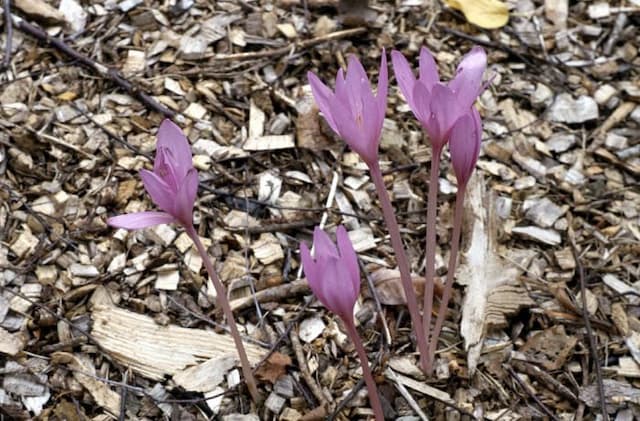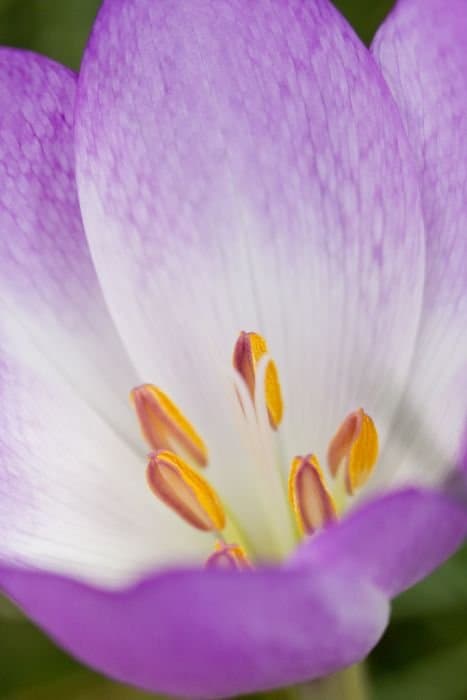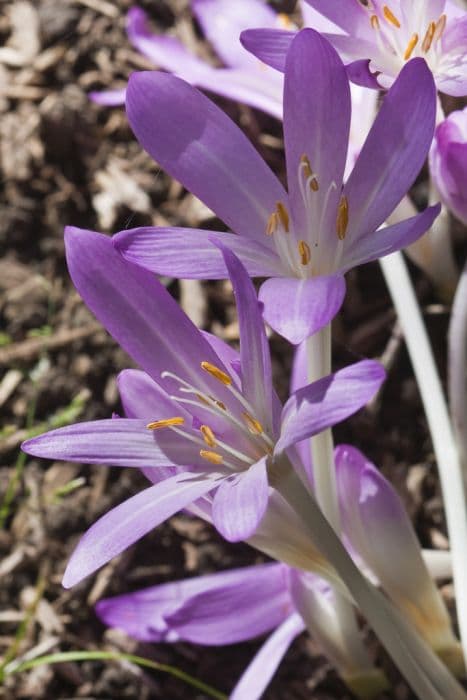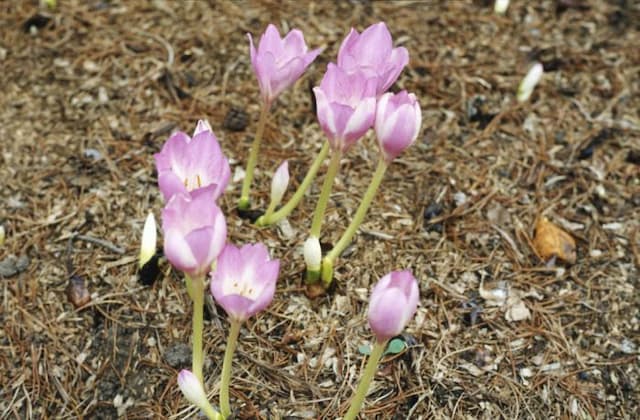Autumn Crocus Colchicum 'Rosy Dawn'

ABOUT
Colchicum 'Rosy Dawn' is a charming ornamental plant known for its striking flowers which bear a great resemblance to crocuses, and like them, it blooms in a notable fashion. The blooms of this variety are particularly enchanting, boasting a delightful shade of soft pink. Each petal is elongated and cupped, merging at the base to form a tube-like structure. The petals often exhibit a gentle gradient of color, deepening to a more vivid pink or sometimes a slight purplish hue towards the tips. The inside of the flower contrasts with light-colored stamens that extend outwards, providing a star-like appearance at the heart of the bloom. The foliage is generally not present during flowering, as this plant exhibits a unique life cycle where the leaves emerge after the blooms have faded. When they do appear, the leaves are typically lush and green, adding to the plant’s visual interest with a verdant backdrop after the floral display. Colchicum 'Rosy Dawn' blooms when many other plants are fading or preparing for dormancy, presenting gardeners with a refreshing burst of color in the landscape. Given its unique flowering time and charming blossoms, this plant has the ability to spark interest and provide a focal point in the garden. Due to this entrancing display, the plant is often used to add a touch of whimsy and surprise to the fall garden palette.
About this plant
 Names
NamesFamily
Colchicaceae.
Synonyms
Autumn Crocus, Meadow Saffron, Naked Lady.
Common names
Colchicum 'Rosy Dawn'.
 Toxicity
ToxicityTo humans
Colchicum 'Rosy Dawn' commonly known as autumn crocus is highly toxic to humans if any part of the plant is ingested. The plant contains colchicine and other alkaloids which are dangerous. Symptoms of autumn crocus poisoning can include gastrointestinal distress such as nausea, vomiting, and diarrhea. In severe cases, organ failure and death can occur due to disruption of cellular division and function.
To pets
Autumn crocus, also known as Colchicum 'Rosy Dawn', is toxic to pets, including cats and dogs. If ingested, the colchicine and other alkaloids within the plant can cause severe gastrointestinal symptoms, including vomiting and diarrhea, as well as respiratory difficulties, seizures, liver and kidney damage, and potentially could be fatal due to multi-organ failure and cardiovascular collapse.
 Characteristics
CharacteristicsLife cycle
Perennials
Foliage type
Deciduous
Color of leaves
Green
Flower color
Pink
Height
6 inches (15 cm)
Spread
3 inches (7.5 cm)
Plant type
Bulb
Hardiness zones
4
Native area
Mediterranean
Benefits
 General Benefits
General Benefits- Aesthetic Appeal: Colchicum 'Rosy Dawn', also known as Autumn Crocus, features vibrant pink flowers that can brighten up gardens and landscapes in the fall season.
- Easy to Grow: Autumn Crocus is known to be low maintenance, requiring minimal care once established, which makes it ideal for both beginner and experienced gardeners.
- Naturalizing: This plant tends to naturalize over time, meaning it can spread and create a fuller look in garden spaces without much intervention.
- Attracts Pollinators: The blossoms of Autumn Crocus can attract pollinators such as bees, which are essential for the health of gardens and the environment.
- Late Bloomer: As it blooms in the late summer to fall, it provides color and interest in the garden during a time when many other plants have finished flowering.
- Drought Tolerant: Once established, Autumn Crocus is relatively drought-tolerant, making it a good choice for gardens in drier climates or where water conservation is a concern.
- Deer and Rodent Resistant: Autumn Crocus is not favored by deer and rodents, reducing the likelihood of damage from these animals.
- Seasonal Interest: Autumn Crocus's foliage appears in spring and dies back in summer, before the flower emerges in fall, providing different visual interest throughout the seasons.
- Container Gardening: It is suitable for pots and containers, offering flexibility for those with limited garden space or who prefer container gardening.
- Hassle-free Propagation: Propagation through division of corms is straightforward, allowing gardeners to easily increase their stock of the plant.
 Medical Properties
Medical Properties- This plant is not used for medical purposes.
 Air-purifying Qualities
Air-purifying QualitiesThis plant is not specifically known for air purifying qualities.
 Other Uses
Other Uses- Flower arrangements: The Rosy Dawn's vibrant flowers can be cut and used in floral arrangements to bring a splash of color indoors during the autumn season.
- Photography prop: Its stunning flowers serve as an exquisite subject for photography enthusiasts, especially in macro photography.
- Educational tool: Botany students can study the Rosy Dawn as part of coursework on plant life cycles and bulbous plants.
- Garden design: Can be used to establish a color theme in a garden design or to contrast with the changing autumn foliage.
- Art inspiration: Artists may use the Rosy Dawn as a muse for paintings, drawings, and textile designs due to its unique color and form.
- Culinary decoration: While not edible, the flowers can be used as a decoration for fancy plates and dining events, provided there's no contact with food.
- Biological pest control: When planted in gardens, they can help deter rodents with their toxic properties, although care must be taken to keep them away from pets and children.
- Bee and pollinator attraction: In bloom, they attract bees and other pollinating insects, contributing to the health of the local ecosystem.
- Symbolic use: The Rosy Dawn can be used symbolically in gardens to represent purity, innocence, or the beginning of a new venture, mirroring its early autumnal bloom.
- Crafting: The dried seed pods and leaves may be used in crafting, such as for making botanical prints or adding to homemade potpourris.
Interesting Facts
 Feng Shui
Feng ShuiThe Autumn Crocus is not used in Feng Shui practice.
 Zodiac Sign Compitability
Zodiac Sign CompitabilityThe Autumn Crocus is not used in astrology practice.
 Plant Symbolism
Plant Symbolism- Endurance and Vitality: Colchicum 'Rosy Dawn,' commonly known as Autumn Crocus, blooms in the fall, symbolizing strength and the ability to thrive in adversity, as it emerges vigorous and colorful at a time when most other plants are fading.
- Rebirth and Renewal: Given that it blooms in autumn, the Autumn Crocus is often associated with renewal and the cyclical nature of life, representing hope and rejuvenation.
- Beauty and Elegance: With its delicate pink petals, the Autumn Crocus exudes elegance and beauty, making it symbolize aesthetics and the appreciation of graceful appearance.
- Caution and Danger: As the Autumn Crocus contains toxic alkaloids like colchicine, it also represents danger and the need to proceed with caution, reflecting its dual nature of being visually appealing yet harmful if mishandled.
 Water
WaterAutumn Crocus needs to be watered when the top inch of soil feels dry, usually every 7 to 10 days, depending on weather conditions and soil drainage. During active growth in the fall, provide them with about one gallon of water per week. Reduce watering after the foliage begins to die back, as overwatering can lead to bulb rot during dormancy. During their summer dormancy period, keep the soil mostly dry, especially in hotter climates, to mimic their natural habitat's conditions. Always water deeply and directly at the soil level to encourage deep root growth and avoid wetting the foliage and flowers.
 Light
LightAutumn Crocus thrives in full sun to partial shade conditions. The ideal spot for these plants is where they receive morning sunlight and some afternoon shade, especially in areas with hot summers. This light condition mimics their natural habitat, providing them with enough energy for flowering while preventing heat stress.
 Temperature
TemperatureAutumn Crocus prefers temperatures between 50°F and 70°F during its active growth and blooming period in the fall. These plants can survive minimum temperatures down to 10°F, making them suitable for USDA hardiness zones 4 through 8. To ensure optimal growth, try to protect them from extreme heat, keeping them cooler during their dormancy in the summer.
 Pruning
PruningAutumn Crocus does not require regular pruning but spent flowers should be removed after blooming to maintain a tidy appearance. Leaves should be allowed to die back naturally; they should not be cut back until they have turned yellow, as this is when the plant is storing energy for the next growing season. Pruning, in this case, is limited to the removal of dead or damaged plant parts usually after flowering in the fall.
 Cleaning
CleaningAs needed
 Soil
SoilAutumn Crocus thrives in a well-draining, compost-rich soil with a pH of 6.0 to 7.0. A mix of equal parts loam, sand, and leaf mold or compost is ideal to create a fertile, airy substrate that mimics their natural conditions.
 Repotting
RepottingAutumn Crocus bulbs do not need frequent repotting and can be left undisturbed for several years. They should only be repotted if the bulbs become overcrowded in their current space or the soil is exhausted.
 Humidity & Misting
Humidity & MistingAutumn Crocus prefers a moderate humidity level but is quite adaptable and does not require any special humidity adjustments, making it suitable for most home environments.
 Suitable locations
Suitable locationsIndoor
Place in bright, indirect light and keep the soil consistently moist.
Outdoor
Plant in partial shade and well-draining soil; water when topsoil is dry.
Hardiness zone
4-9 USDA
 Life cycle
Life cycleThe life cycle of the Colchicum 'Rosy Dawn', also known as autumn crocus, begins with bulb formation underground, usually in late summer to early fall. During this stage, the bulb lies dormant until the environmental conditions trigger sprouting of the foliage and flowers. Typically, the plant produces vibrant, pink to lavender flowers in the fall, emerging directly from the ground before the leaves appear. After the blooming period, the plant develops long, strappy leaves which photosynthesize to replenish the bulb's energy reserves through the winter and into spring. Once the leaves die back in early summer, the plant enters a period of dormancy, conserving energy in the bulb until the cycle restarts in the fall. The plant spreads either by seed or vegetatively through the division of bulbs.
 Propogation
PropogationPropogation time
Late summer
Propogation: Colchicum 'Rosy Dawn', commonly referred to as autumn crocus, is typically propagated by dividing its corms. The most popular method for propagation is to divide the corms after the leaves have died back, usually in the late spring or early summer. Carefully dig up the corms and gently separate them, ensuring that each division has at least one growth point. Replant the corms immediately at a depth of about 3 to 4 inches (7.6 to 10.2 cm) with appropriate spacing to allow for future growth. This method allows the new plants to establish themselves over the summer, ready to bloom in the following autumn.









